Greg Knowler
-
- CMA CGM - Showing the Way Forward Maritime Logistics Professional, Q1 2013 #40
Success in a down market? It is possible, as MarPro found at one of the world’s largest carriers in one of shipping’s most volatile sectors.
When CMA CGM signed a deal selling 49% of its Terminal Link division to China Merchants Holdings (International) for $535 million in January 2013, it sealed a remarkable turnaround for the world’s third largest container carrier. Just three years ago, the Marseilles-based shipping company controlled by the Saade family was almost crippled by debt, struggling with heavy losses in 2009 after the financial crisis. Improvements in 2010 were wiped out by a slump in freight rates in 2011.
Late last year, however, the French line surprised the world when it announced it was on course for a full-year profit. Its results in the nine months up to September showed a profit of $284 million, no small achievement in a highly volatile trading environment. At the time of writing the final 2012 financial results for CMA CGM and its peers were not yet available, but the profit warnings were coming thick and fast.
Bucking the Trend
Across the container shipping industry, carriers are preparing to report significant losses attributable to excess capacity of container vessels, falling demand, rising fuel prices and weak freight rates. Too much supply, too little demand and too high costs – a cycle of diminishing returns.
China’s biggest shipping company, the state-controlled Cosco, warned in late January that it would report “a large net loss” for 2012. The shipping giant did not indicate the size of the loss but analysts were more than happy to provide an estimate: $1 billion. Maersk’s container division expects a “negative” result for the past year after losing $521 million in 2011 and puts the blame on overcapacity and a 25% drop in global freight rates in 2012. On Asia-Europe, the Danish carrier said the drop in prices was almost 60%. Separately, NOL’s liner shipping business APL announced that it expected to post a full year loss for 2012 and German line Hapag Lloyd was down 94% for the first nine months and unlikely to claw its way back into the black.
Family Recipe
Curiously, the French company operates on the same trades and on the same planet as these carriers, so how did the line manage to profit while the competition founded in turbulent financial waters? To find the answer, we need to travel back to the dark days of 2009. By the middle of that year, CMA CGM was in serious trouble. The French line had built up debts of $5.6 billion, and its orderbook in that crippling post financial crisis period was 60% of its fleet. The carrier could simply not continue to operate with such a chronic debt overhang. Retail spending across the world’s major markets had dried up, and as the transporters of 90% of global consumer goods, container shipping companies were being hit hard. CMA CGM needed help, and fast. Going out of business was not an option, and the determination of the founding Saade family to maintain control of the line it has run for more than three decades simply cannot be overstated.
CMA (Compagnie Maritime d’Affretement) was established by Jacques Saade in 1978, a Lebanese who settled in Marseilles and started his line with one 200 TEU ship, initially serving Mediterranean Europe, Lebanon and Syria, where brother Johnny Saade managed the agencies, then expanding to North Africa, a Dynamar report stated.
In 1999, CMA merged with state-owned CGM (Compagnie Generale Maritime), a loss-making entity that the French government finally decided to privatize. Because CGM had withdrawn from several trades before its privatization, the move was a logical one and served the new carrier well.
Jacques Saade proved to be an astute shipping executive, building his liner services even as the container market began to expand across the long-haul trade lanes.
Most of CMA CGM’s growth has been by acquisition, but two large purchases stand out. In 2007, the French line acquired Cheng Lie Navigation of Taiwan, an intra-Asia specialist, and US Lines that served the US West Coast and Australasia trade. US Lines is a subsidiary of CMA CGM-owned ANL Container Line. Those acquisitions opened new markets, but came just a year before the greatest financial meltdown the world had ever seen. The financial crisis hit while container lines were riding a wave of profitability with the newbuilding orderbook reaching far into the distance.
Orderbooks & Overcapacity
At the beginning of 2009, CMA CGM had orders for 73 ships comprising a total of 596,000 TEUs, 60% of its fleet. The financing of these vessels was a huge contributor to the massive debt that had been accumulated by the line. The orderbook was looking more like the plank. That’s because in January 2009, container throughput in Shanghai, then the world’s second-busiest container port, plunged 15%; in Shenzhen the drop was a steeper 17.5%. The declines were the worst year-on-year performance ever for the two ports. And in Hong Kong, container throughput fell 23.2% in January, the worst container throughput since the early 1990s.
The financial impact of China’s falling exports on container lines was devastating. First half industry losses in 2009 reached $6.9 billion, with CMA CGM down more than $700 million. With Saade family control as a non-negotiable position, the line went in search of ways to restructure its mounting debts. By the middle of 2009, a committee of 77 banks and financial institutions was involved in restructuring the debt and coming up with an interim package. But what CMA CGM also desperately required was an injection of cash, and the line began casting about for potential investors. The white knights eventually arrived in 2010 in the form of Turkish family-owned container terminal and shipping operator Yildirim Group with an investment of around $500 million in return for five-year convertible bonds equal to 20% of the share capital and three seats on the board.
A bond issue in the first half of 2011 raised around $950 million and CMA CGM reached an agreement with creditor banks on its debt restructuring. It also cancelled orders for 12 vessels, postponed the delivery of 30 others, sold 50% of its stake in Malta Freeport to Yildirim for $285 million and implemented a vigorous cost-cutting program.
In 2012, the carrier saw Yildirim adding another $100 million into the French line, giving it the rights to an additional 4% stake in the company, along with additional investment from French sovereign fund Fonds Stratégique d’Investissement (FSI) that injected $150 million in bonds redeemable as shares.
Alphaliner valued CMA CGM equity after the September 2012 deal at $2.5 billion with a net debt of $5 billion, giving CMA CGM a total enterprise value of $7.5 billion. The Terminal Link sale to CMHI in January 2013 capped a remarkable period for the French company.
“The finalization of the debt restructuring combined with new equity injection from FSI and Yildirim Group and the sale of 49% of Terminal Link will allow CMA CGM to operate with the required financial flexibility and constitutes key milestones before contemplating an IPO,” CMA CGM executive officer Rodolphe Saade said in a recent statement. With other CMA CGM executives unavailable for comment in this story, we turned to the shipping analysts to find out how the carrier had managed to turn its bleak position around.
Maritime consultancy Dynamar’s Dirk Visser said CMA CGM was not doing anything “radically different” to the other carriers to finish the year in the black. “But perhaps it has benefitted from the aggregation of marginal gains, teeny improvements here, there and all over that add up to a significant improvement,” Visser said. He added, “As such, we don’t think that CMA CGM’s Q2 and Q3 2012 results are actually the results of what they have done in 2012, more accurately accruing the benefit from a range of measures they undertook before and during 2012.”
Visser said those measures included interim agreements with banks in 2009, the entrance of Yildirim as a shareholder in 2011, reducing and better managing the orderbook (now just 15 ships), selling vessels, cutting costs, controlling charter costs and entering into deeper strategic partnerships with Maersk and MSC.
Lars Jensen of SeaIntel said the Maersk and MSC partnerships made a significant contribution to the line’s turnaround, as “that has indeed allowed them access to the lower unit costs of large vessels on some of the main trades.” Separately, an Alphaliner report said the superior performance of CMA CGM and Maersk were more closely related to their trade mix. “Compared to their competitors, both carriers have a large share of volumes on the Asia-Europe and Latin America trades, which have performed better than other trade lanes during the third quarter,” the report stated.
Drewry’s senior manager of equity research Rahul Kapoor said CMA CGM’s better than market expectations performance in 2012 was primarily driven by a strong recovery in freight rates in its core trade lanes, volume gains and achieved cost efficiencies. “Along with recovery in freight rates, the positive tailwinds from declining fleet wide bunker consumption due to further slow steaming and tighter cost controls including network optimization and reduction in chartering costs paved way for much improved operating performance,” Kapoor said.
Analyzing the last reported third quarter numbers, Kapoor said the French line had already achieved $550 million in cost savings for the first three quarters of 2012, surpassing an initial full year FY12 savings target of $400 million. “Company operating expenses suggest higher cost efficiencies were gained from lower bunker and chartering costs,” he said.
Achieving success in a down market is indeed possible, and the carrier has managed to fight its way out of a tight corner. The series of measures CMA CGM was forced to implement over the last three years may have diluted the Saade family share of the business, but they have left the carrier executives wiser and the line in a better position to capitalize when general rates increases are successfully implemented.
(As published in the 1Q edition of Maritime Professional - www.maritimeprofessional.com) -
- Boxed In Maritime Reporter, Jun 2013 #46
It is impossible to view the global container shipping business without looking at it through the prism of vessel capacity being added to the market. What happens over the next two years will be a direct result of the glut of newbuildings that are flooding into service and wrecking freight rates. Just
-
- Maersk Rate Hikes Hitting the High Notes Maritime Reporter, Jun 2013 #8
Do we sense a touch of desperation from the executive corridors of Maersk Line as the Triple-E delivery dates approach? Maersk Line boss Nils Smedegaard Andersen was in a confident mood after his carrier posted a decent $204 million profit in the first quarter. Making a profit when Asia-Europe is a
-
- Maersk & New Containership Economics 101 Maritime Reporter, Oct 2013 #34
Capacity management is firmly on the minds of Maersk executives as the largest container ships in the world steam into service. Photographs of Maersk Line’s 18,000 TEU ships are flooding in from ports around the world as the carrier phases its giant new vessels phase into the AE10 string between Asia
-
 )
March 2024 - Marine Technology Reporter page: 43
)
March 2024 - Marine Technology Reporter page: 43Discovery Image courtesy Teledyne Marine New Products Teledyne Marine had its traditional mega-booth at Oi, busy start to ? nish. Image courtesy Greg Trauthwein offers quality sub-bottom pro? ling capability without the need tion of offshore windfarms. GeoPulse 2 introduces new capa- for any dedicated
-
 )
March 2024 - Marine Technology Reporter page: 42
)
March 2024 - Marine Technology Reporter page: 42NEW TECH OCEANOLOGY INTERNATIONAL 2024 Image courtesy Greg Trauthwein Image courtesy BIRNS MacArtney launches the new ultra-compact ø12.7 mm SubConn Nano connector. Innovative connectivity built on 45 years of ? eld-proven and market-trusted design. Image courtesy MacArtney Birns celebrated its 70th
-
 )
March 2024 - Marine Technology Reporter page: 30
)
March 2024 - Marine Technology Reporter page: 30is ? tted with low-im- model different scenarios to reduce this impact, says Dr pact tracks, and to further limit sediment disturbance, it has a Greg Stone, Chief Ocean Scientist. ? nes rejection system. Research conducted by Nauru Ocean Resources, a subsid- This type of technology was ? rst tested
-
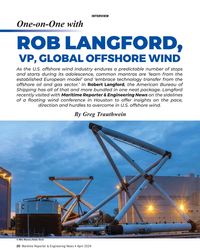 )
April 2024 - Maritime Reporter and Engineering News page: 20
)
April 2024 - Maritime Reporter and Engineering News page: 20News on the sidelines of a ? oating wind conference in Houston to offer insights on the pace, direction and hurdles to overcome in U.S. offshore wind. By Greg Trauthwein © Mike Mareen/Adobe Stock 20 Maritime Reporter & Engineering News • April 2024 MR #4 (18-33).indd 20 4/5/2024 8:14:13 A
-
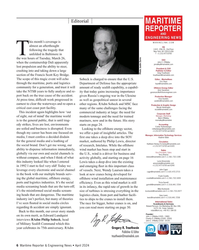 )
April 2024 - Maritime Reporter and Engineering News page: 6
)
April 2024 - Maritime Reporter and Engineering News page: 6apparently [email protected] lost propulsion and the ability to steer, President & COO Publisher & Editor crashing into and taking down a large Greg Trauthwein Photo Justin Zurre [email protected] section of the Francis Scott Key Bridge. The scope of this tragic event will echo Sobeck
-
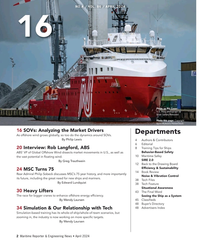 )
April 2024 - Maritime Reporter and Engineering News page: 2
)
April 2024 - Maritime Reporter and Engineering News page: 2Safety ABS’ VP of Global Offshore Wind dissects market movements in U.S., as well as 10 Maritime Safey the vast potential in ? oating wind. SIRE 2.0 By Greg Trauthwein 12 Back to the Drawing Board Ef? ciency & Sustainability 24 MSC Turns 75 14 Book Review Rear Admiral Philip Sobeck discusses MSC’s 75
-
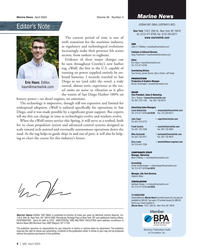 )
April 2024 - Marine News page: 4
)
April 2024 - Marine News page: 4and technological evolutions John C. O’Malley • [email protected] increasingly make their presence felt across Publisher & Editorial Director Greg Trauthwein • [email protected] sectors, from tankers to tugboats. Evidence of these major changes can Editor Eric Haun • [email protected] be
-
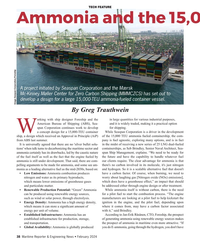 )
February 2024 - Maritime Reporter and Engineering News page: 38
)
February 2024 - Maritime Reporter and Engineering News page: 38Carbon Shipping (MMMCZCS) has set out to develop a design for a large 15,000-TEU ammonia-fueled container vessel. Image Seaspan Corporation/Foreship By Greg Trauthwein orking with ship designer Foreship and the in large quantities for various industrial purposes, American Bureau of Shipping (ABS), Sea-
-
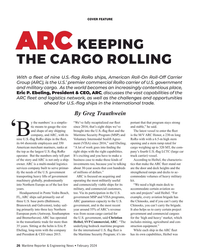 )
February 2024 - Maritime Reporter and Engineering News page: 26
)
February 2024 - Maritime Reporter and Engineering News page: 26of the ARC ? eet and logistics network, as well as the challenges and opportunities ahead for U.S.-? ag ships in the international trade. By Greg Trauthwein y the numbers’ is a simplis- “We’ve fully recapitalized our ? eet portant that that program stays strong tic means to gauge the size
-
 )
February 2024 - Maritime Reporter and Engineering News page: 22
)
February 2024 - Maritime Reporter and Engineering News page: 22the megatrends of decarbonization, energy transition and autonomy all inspire Image courtesy Wabtec and impact the marine power solutions from Wabtec. By Greg Trauthwein Matt, to start us off, can you provide insight on Wabtec is huge, pervasive in power across in- the journey to your present position? dustries
-
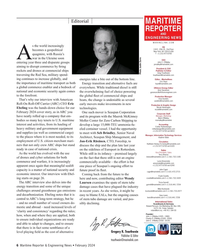 )
February 2024 - Maritime Reporter and Engineering News page: 6
)
February 2024 - Maritime Reporter and Engineering News page: 6disparate groups [email protected] aiming to disrupt commerce by ? ring President & COO Publisher & Editor rockets and drones at commercial ships Greg Trauthwein Photo Justin Zurre [email protected] traversing the Red Sea, military spend- ing continues to increase globally, and energies take
-
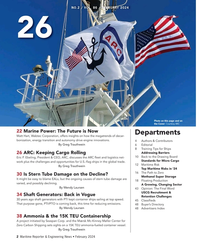 )
February 2024 - Maritime Reporter and Engineering News page: 2
)
February 2024 - Maritime Reporter and Engineering News page: 2, offers insights on how the megatrends of decar- bonization, energy transition and autonomy drive engine innovations. 4 Authors & Contributors By Greg Trauthwein 6 Editorial 8 Training Tips for Ships Addressing Barriers 26 ARC: Keeping Cargo Rolling 10 Back to the Drawing Board Eric P. Ebeling, President
-
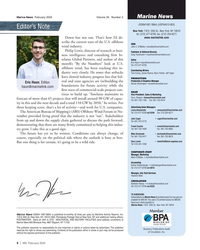 )
February 2024 - Marine News page: 4
)
February 2024 - Marine News page: 4the U.S. offshore CEO wind industry. John C. O’Malley • [email protected] Philip Lewis, director of research at busi- Publisher & Editorial Director Greg Trauthwein • [email protected] ness intelligence and consulting ? rm In- telatus Global Partners, and author of this Editor Eric Haun • haun@marine
-
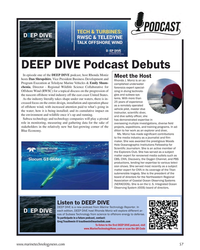 )
January 2024 - Marine Technology Reporter page: 57
)
January 2024 - Marine Technology Reporter page: 57Rhonda Moniz will explore different ar- eas of Subsea Technology from science to offshore energy to defense. To participate in a future podcast, contact: Greg Trauthwein @ [email protected] To listen to the ? rst DEEP DIVE podcast, visit www.MarineTechnologyNews.com or scan the QR Code www.marinetechnolog
-
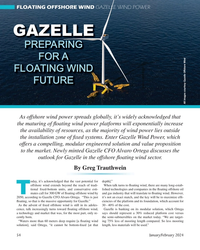 )
January 2024 - Marine Technology Reporter page: 54
)
January 2024 - Marine Technology Reporter page: 54and value proposition to the market. Newly minted Gazelle CFO Alvaro Ortega discusses the outlook for Gazelle in the offshore ? oating wind sector. By Greg Trauthwein oday, it’s acknowledged that the vast potential for depth].” offshore wind extends beyond the reach of tradi- When talk turns to ? oating
-
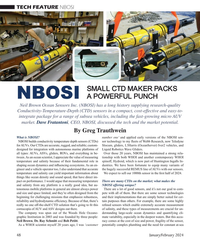 )
January 2024 - Marine Technology Reporter page: 48
)
January 2024 - Marine Technology Reporter page: 48for a range of subsea vehicles, including the fast-growing micro AUV market. Dave Fratantoni, CEO, NBOSI, discussed the tech and the market potential. By Greg Trauthwein What is NBOSI? number one’ and applied early versions of the NBOSI sen- NBOSI builds conductivity temperature depth sensors (CTDs) sor technology
-
 )
January 2024 - Marine Technology Reporter page: 18
)
January 2024 - Marine Technology Reporter page: 1814 months of operational experience under its belt, and the goal for 2024 is completion of that trial and continuing the path toward commercialization. By Greg Trauthwein To start us off, can you give us a by the numbers look at in Ocean Engineering at Oregon State University, which is Mocean Energy today
-
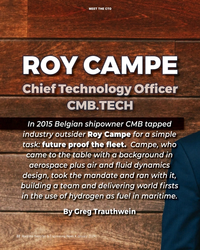 )
January 2024 - Maritime Reporter and Engineering News page: 22
)
January 2024 - Maritime Reporter and Engineering News page: 22? uid dynamics design, took the mandate and ran with it, building a team and delivering world ? rsts in the use of hydrogen as fuel in maritime. By Greg Trauthwein 22 Maritime Reporter & Engineering News • January 2024 MR #1 (18-33).indd 22 1/8/2024 11:13:11 A
-
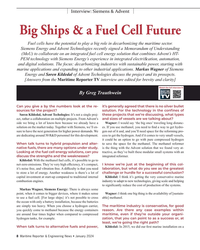 )
January 2024 - Maritime Reporter and Engineering News page: 8
)
January 2024 - Maritime Reporter and Engineering News page: 8discuss the project and its prosepcts. [Answers from the Maritime Reporter TV interview are edited for brevity and clarity] Watch the full interview @ By Greg Trauthwein Can you give a by the numbers look at the re- it’s generally agreed that there is no silver bullet sources for the project? solution. For
-
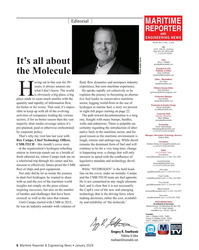 )
January 2024 - Maritime Reporter and Engineering News page: 6
)
January 2024 - Maritime Reporter and Engineering News page: 6St., 2nd Floor New York, NY 10010 USA T +1.212.477.6700 CEO John C. O’Malley It’s all about [email protected] President & COO Publisher & Editor Greg Trauthwein the Molecule Photo Justin Zurre [email protected] Editor - MarineNews Eric Haun aving sat in this seat for 30+ ? uid, ? ow dynamics
-
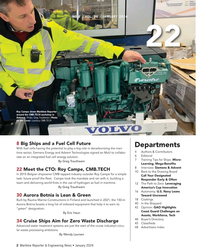 )
January 2024 - Maritime Reporter and Engineering News page: 2
)
January 2024 - Maritime Reporter and Engineering News page: 2NO.1 / VOL. 86 / JANUARY 2024 22 Roy Campe shows Maritime Reporter around the CMB.TECH workshop in Antwerp. Photo: Greg Trauthwein | Photo on the Cover: courtesy CMB.TECH 8 Big Ships and a Fuel Cell Future Departments With fuel cells having the potential to play a big role in decarbonizing the mari- 4
-
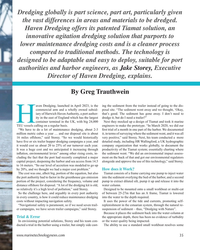 )
November 2023 - Marine Technology Reporter page: 35
)
November 2023 - Marine Technology Reporter page: 35to be adaptable and easy to deploy, suitable for port authorities and harbor engineers, as Jake Storey, Executive Director of Haven Dredging, explains. By Greg Trauthwein aven Dredging, launched in April 2023, is the ing the sediment from the trailer instead of going to the dis- commercial arm and a wholly
-
 )
November 2023 - Marine Technology Reporter page: 30
)
November 2023 - Marine Technology Reporter page: 30for its defense customers, as well as the keys to attracting and retaining the engineering talent that will drive Massa for the next generation. By Greg Trauthwein 30 November/December 2023 MTR #8 (18-33).indd 30 11/28/2023 10:57:25 A
-
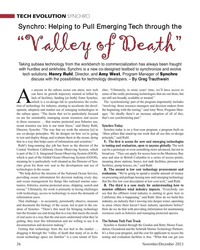 )
November 2023 - Marine Technology Reporter page: 26
)
November 2023 - Marine Technology Reporter page: 26and evolve tech solutions. Henry Ruhl, Director, and Amy West, Program Manager of Synchro discuss with the possibilities for technology developers. – By Greg Trauthwein s anyone in the subsea sector can attest, new tech chro. “Ultimately, in some years’ time, we’ll have access to can have its growth trajectory
